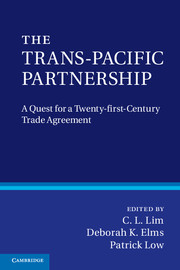Book contents
- Frontmatter
- Contents
- List of Figures and Tables
- Contributors
- Preface
- Acknowledgements
- Disclaimer
- Glossary
- Part I Introduction
- Part II The past: origins of the TPP Agreement
- 2 An overview and snapshot of the TPP negotiations
- 3 US PTAs
- 4 From the P4 to the TPP
- 5 Incorporating development among diverse members
- Part III The present: twenty-first century elements and obstacles
- Part IV The future: high-quality meets regional and global realities
- Part V The TPP negotiations: the quest for quality
- Index
- References
4 - From the P4 to the TPP
transplantation or transformation?
Published online by Cambridge University Press: 05 November 2012
- Frontmatter
- Contents
- List of Figures and Tables
- Contributors
- Preface
- Acknowledgements
- Disclaimer
- Glossary
- Part I Introduction
- Part II The past: origins of the TPP Agreement
- 2 An overview and snapshot of the TPP negotiations
- 3 US PTAs
- 4 From the P4 to the TPP
- 5 Incorporating development among diverse members
- Part III The present: twenty-first century elements and obstacles
- Part IV The future: high-quality meets regional and global realities
- Part V The TPP negotiations: the quest for quality
- Index
- References
Summary
Introduction
From the very beginning, the P4 Agreement was conceived as a catalyst for a broader free trade agreement (hereafter “FTA”) that would ultimately include most major economies in the Asia-Pacific. That is why the P4 Agreement includes an explicit clause that allows “any APEC economy or other state” to seek accession.
With Australia, Malaysia, Peru, the United States, Viet Nam and a host of other countries lining up to join the TPP, the P4 is making good progress towards expanding into a truly trans-Pacific mega-deal. The transition from the P4 to the TPP can be achieved in either of two possible ways: the first is the simpler route of transplanting the existing framework of the P4 into the TPP; the second is making a substantial transformation and going deeper than what the P4 has achieved. What are the pros and cons of each approach? Which route shall be taken? What is the likely outcome based on the current negotiating dynamic? In this chapter, I will try to provide some answers to these questions.
- Type
- Chapter
- Information
- The Trans-Pacific PartnershipA Quest for a Twenty-first Century Trade Agreement, pp. 64 - 81Publisher: Cambridge University PressPrint publication year: 2012
References
- 2
- Cited by



